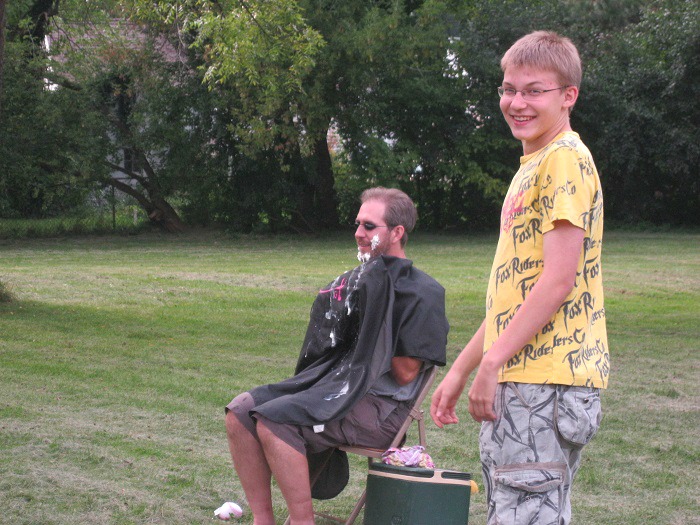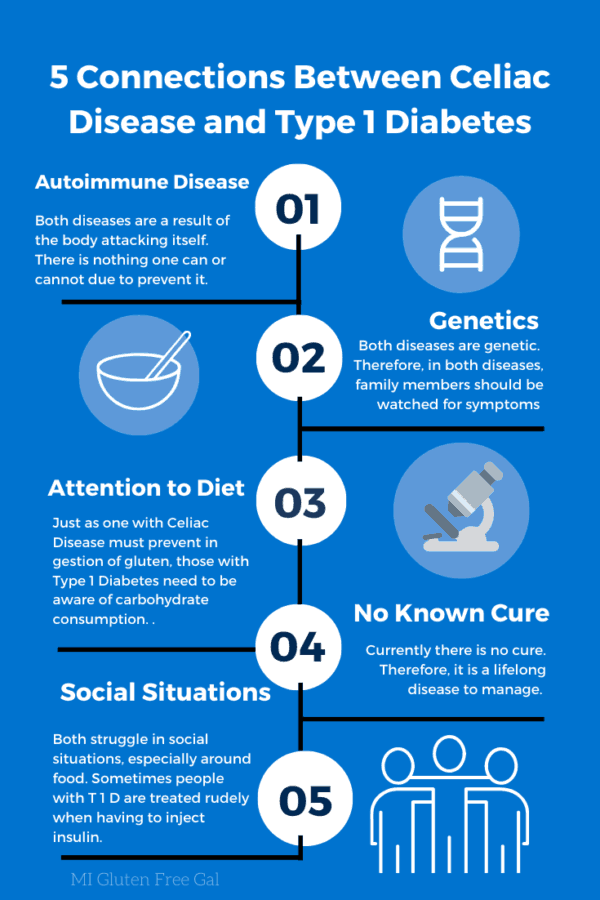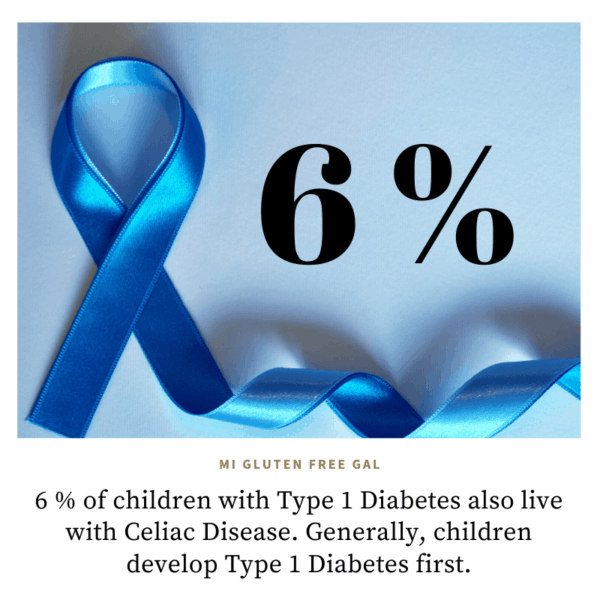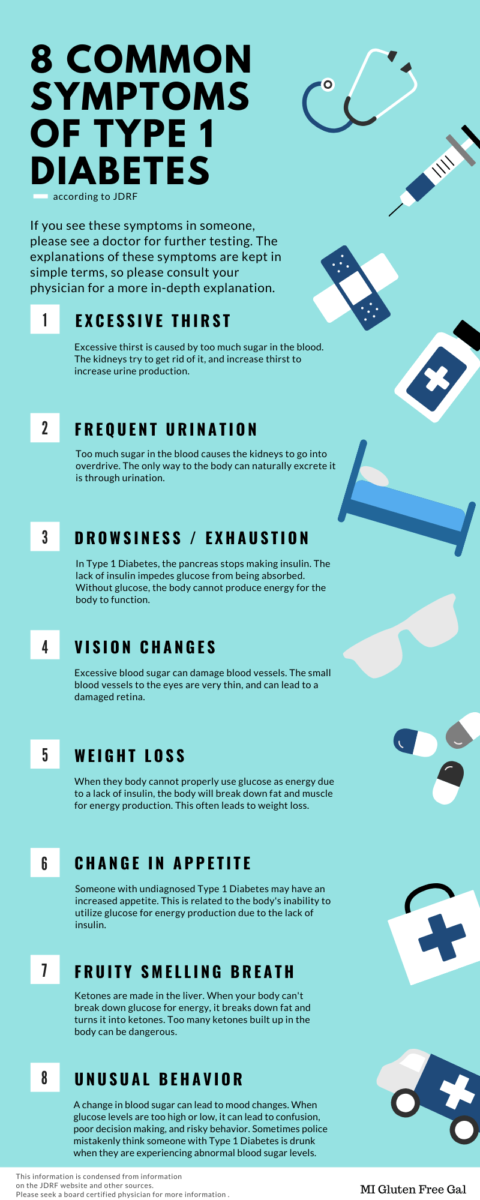Connecting Type 1 Diabetes and Celiac Disease
As an Amazon Associate and member of other affiliate programs, I earn from qualifying purchases.
Type 1 Diabetes affects of 1.25 million Americans. Beyond Type One estimates that 40,000 people receive a Type 1 Diabetes (T1D) diagnosis every year. They state T1 International found 25% of people surveyed rationed their insulin due to cost. For this and many more reasons, we need to learn more about this serious disease.

“Type 1 D Looks Like Me”
Just like Celiac Disease, those living with Type 1 Diabetes look “normal.” It’s hard when people say “but you don’t look sick.” Living with Celiac Disease is hard, especially as a kid. However, living with T1D and Celiac Disease is even harder. Our former exchange student, Daniel, could have told you this and more.
Outside of genetics, people with these two diseases have a lot in common. Neither person did anything to “cause” their disease. Each has to pay attention to what they eat. Both have difficulty in social situations, which can increase feelings of depression. Left untreated, those with each disease can have serious long lasting complications. Even death.

My Type 1 Diabetes Education
I really didn’t know much about Type 1 Diabetes until we had a foreign exchange student. That’s Daniel, in the picture at the top of the page. I think he’s smiling so widely because my husband is covered in shaving cream. And he put it there. 🙂
I wish I could say all of my pictures of Daniel have wide smiles. Living with these two diseases took its toll on him. We received quite a crash course in the disease. While here, Daniel landed in the hospital with diabetic ketoacidosis. I learned that these two diseases have quite a bit in common.

Patients diagnosed with both diseases under the age of 2 are often diagnosed with Type 1 Diabetes first. Typically, an additional Celiac Disease diagnosis occurs within four years. Some of the symptoms of these two diseases can overlap, so it can be hard to pinpoint one prior to the other. Living with either disease should encourage us to know more about the other.
Recognizable Symptoms of Type 1 Diabetes

The Struggles of Living with Type 1 D
Having Type 1 Diabetes and Celiac Disease poses interesting challenges. So much of monitoring Type 1 Diabetes is keeping blood glucose levels even. Eating whole grains greatly helps with this. However, those on a gluten-free diet often consume fewer whole grains. Gluten-free foods are highly processed and are often higher in carbohydrates
As children with these diseases get older, they may “cheat.” In a online Type 1 D Support Group I’m connected to, parents often post concerns about their children who don’t take testing supplies or insulin with them. We sometimes see that same teenage “rebellion” in in the Celiac Disease community. The Dr. Schar Institute research indicates that 11% of teens with Celiac Disease knowingly ate wheat-based foods due to awkward social situations.
The damage gluten causes to the intestine affects the absorption of carbohydrates and insulin. This can lead to wildly varying blood glucose levels. This often alerts to the possibility of Celiac Disease. Below is a story of a young girl, pre Celiac Disease diagnosis, and how it affected her blood glucose levels.

How Gluten Affects a Child with Type 1 Diabetes
“Before her Celiac diagnosis our daughter would have wild rises or falls in her Blood Glucose. The worst instance was when we did a finger poke test. Her blood glucose measured over 300! We gave her some insulin and sent her out to jump on the trampoline to try to bring that number down.
About 30 minutes later, we tested her again. 34. It was crazy! It made it completely impossible to control her diabetes. Because her intestines were damaged by Celiac, she wasn’t absorbing the carbs we gave her at meal time like she should. But her body sometimes accepted the insulin fine.
So we would have terrible lows and then ridiculous highs when the food finally reached a healthy part of her intestines and was able to absorb the nutrients. Then we would give more insulin to treat the high and the cycle would continue. It was the wild fluctuations that led her endocrinologist to have her tested for Celiac.
A Blood Glucose under 40 is at risk of coma. With sugar dropping that fast, we could have lost her. Thank God she was still awake and able to swallow. Many people cannot swallow or function at that low of a Blood Glucose. We have gel we can rub into her gums in that case or we can give her the big shot – Glucagon. Since removing gluten from her diet, we have not had near as many lows and certainly not as severe.
Type 1 Diabetes Resources

- JDRF offers backpacks full of resources. Learn more about their Bag of Hope and Adult T1D Care Kit. The Bag of Hope is geared towards children diagnosed with T1D, and the Care Kit is geared towards adults diagnosed with T1D. (And yes, adults can be diagnosed with Type 1 Diabetes.)
- Beyond Type One focuses on “education, advocacy and the path to a cure for Type 1 diabetes.”
- T 1 International advocates for the more than 1 million people in the world living with Type 1 Diabetes.
- I highly recommend following Milk and Honey Nutrition. A registered dietitian, she also lives with Type 1 Diabetes. She also has a post about traveling with diabetes that’s great.
- The American Diabetes Association sponsors Type 1 Diabetes youth camps around the nation. In the midwest, it is held at Camp Copneconic in Fenton, Michigan.
- I’m sure there are many resources I am forgetting. Let me know of others you use, in the comments below.

Type 1 Diabetes’ Impact on My Celiac Disease Advocacy
Our time with Daniel and learning about Type 1 Diabetes has had a profound impact on me. I stay connected with the local online JDRF group to provide support for those newly diagnosed with Celiac Disease. I keep myself abreast of T1D research, hoping with these parents for a cure. Watching the struggles these parents go through is heartbreaking and sometimes terrifying.
Sadly, Daniel died in November of 2016. I couldn’t go to Finland for the funeral or console his family. However, I can use my platform as a blogger to honor his memory by bringing awareness to the disease he struggled with daily. After all, the Celiac Disease community knows what it is to live with an “invisible” disease. We have to look out for one another.
Do you or a child live with Type 1 Diabetes? What’s your diagnosis story? What do you wish people knew? Please feel free to share your story below.
